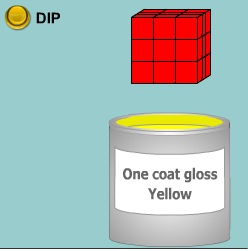Painted Cube: Difference between revisions
JanetBlair (talk | contribs) No edit summary |
m (subjects, ages, types) |
||
| Line 1: | Line 1: | ||
{{ResourcePageGroupMenu|NRICH}} | {{ResourcePageGroupMenu|NRICH}} | ||
{{Rinfo | {{Rinfo | ||
|type= Lesson idea | |||
|title= Painted Cube | |title= Painted Cube | ||
|tagline= Imagine a large cube made from small red cubes being dropped into a pot of yellow paint. How many of the small cubes will have yellow paint on their faces? | |tagline= Imagine a large cube made from small red cubes being dropped into a pot of yellow paint. How many of the small cubes will have yellow paint on their faces? | ||
| Line 9: | Line 11: | ||
|subject=Maths | |subject=Maths | ||
|resourcenumber= M0042 | |resourcenumber= M0042 | ||
|age=Secondary | |age= KS3, Secondary | ||
|Learning Objectives= Exploring and noticing structure | |Learning Objectives= Exploring and noticing structure | ||
|toc= | |toc= | ||
Revision as of 15:37, 28 September 2012
This resource may not be final.
Teaching approach. This lesson idea is about exploring and noticing structure(ta).
The collection of NRICH activities are designed to develop students capacity to work as a mathematician. Exploring, questioning, working systematically, visualising, conjecturing, explaining, generalising, justifying, proving are all at the heart of mathematical thinking.
This particular resource has been adapted from an original NRICH resource. NRICH promotes the learning of mathematics through problem solving. NRICH provides engaging problems, linked to the curriculum, with support for teachers in the classroom. Working on these problems will introduce students to key mathematical process skills. They offer students an opportunity to learn by exploring, noticing structure and discussing their insights, which in turn can lead to conjecturing, explaining, generalising, convincing and proof.
The Teachers’ Notes provided focus on the pedagogical implications of teaching a curriculum that aims to provoke mathematical thinking. They assume that teachers will aim to do for students only what they cannot yet do for themselves. As a teacher, consider how this particular lesson idea can provoke mathematical thinking. How can you support students' exploration? How can you support conjecturing, explaining, generalising, convincing and proof?. (edit)
| Resource details | |
| Title | Painted Cube |
| Topic | |
| Teaching approach | |
| Learning Objectives | Exploring and noticing structure |
| Format / structure | |
| Subject | |
| Age of students / grade | |
| Table of contents | |
| Additional Resources/material needed | |
| Useful information | |
| Related ORBIT Wiki Resources |
|
| Other (e.g. time frame) | |
| Files and resources to view and download |
|
| Acknowledgement | The NRICH website http://nrich.maths.org publishes free mathematics resources designed to challenge, engage and develop the mathematical thinking of students aged 5 to 19. NRICH also offers support for teachers by publishing Teachers’ Resources for use in the classroom. |
| License | CC-By, with kind permission from NRICH. This resource was adapted from an original NRICH resource. |

